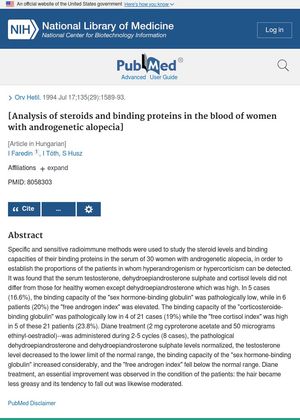Analysis of Steroids and Binding Proteins in the Blood of Women with Androgenetic Alopecia
July 1994
in “
PubMed
”
androgenetic alopecia steroids binding proteins serum testosterone dehydroepiandrosterone dehydroepiandrosterone sulphate cortisol sex hormone-binding globulin free androgen index corticosteroid-binding globulin free cortisol index Diane treatment cyproterone acetate ethinyl-oestradiol androgenic alopecia DHEA SHBG CBG Diane-35

TLDR Women with androgenetic alopecia have normal levels of most blood steroids and binding proteins, but higher dehydroepiandrosterone. Some also have low "sex hormone-binding globulin" and "corticosteroide-binding globulin" capacity, and high "free androgen index" and "free cortisol index". Diane treatment can normalize these levels and improve hair conditions.
In 1994, a study was conducted on 30 women with androgenetic alopecia to analyze the levels of steroids and binding proteins in their blood. The researchers used specific and sensitive radioimmune methods and found that the serum testosterone, dehydroepiandrosterone sulphate, and cortisol levels were similar to those of healthy women, except for dehydroepiandrosterone which was high. In 16.6% of the cases, the binding capacity of the "sex hormone-binding globulin" was pathologically low, and in 20% of the patients, the "free androgen index" was elevated. The "corticosteroide-binding globulin" had a pathologically low binding capacity in 19% of 21 cases, and the "free cortisol index" was high in 23.8% of these 21 patients. After administering Diane treatment (2 mg cyproterone acetate and 50 micrograms ethinyl-oestradiol) for 2-5 cycles in 8 cases, the pathological dehydroepiandrosterone and dehydroepiandrosterone sulphate levels normalized, the testosterone level decreased to the lower limit of the normal range, and the "free androgen index" fell below the normal range. The treatment also led to significant improvements in the patients' conditions, with their hair becoming less greasy and falling out less.


